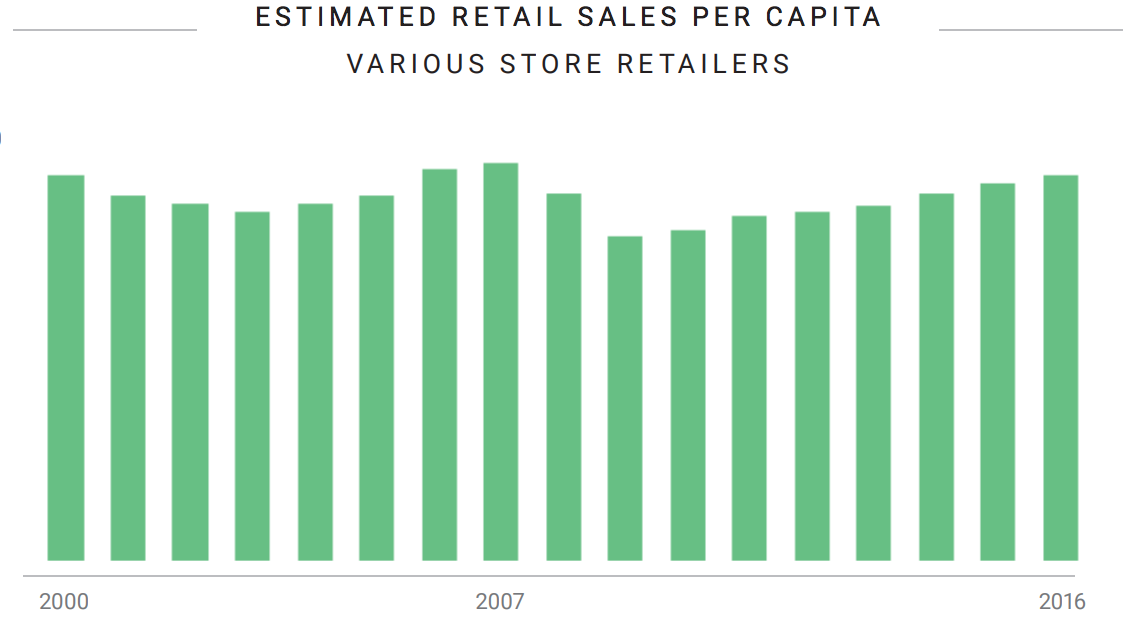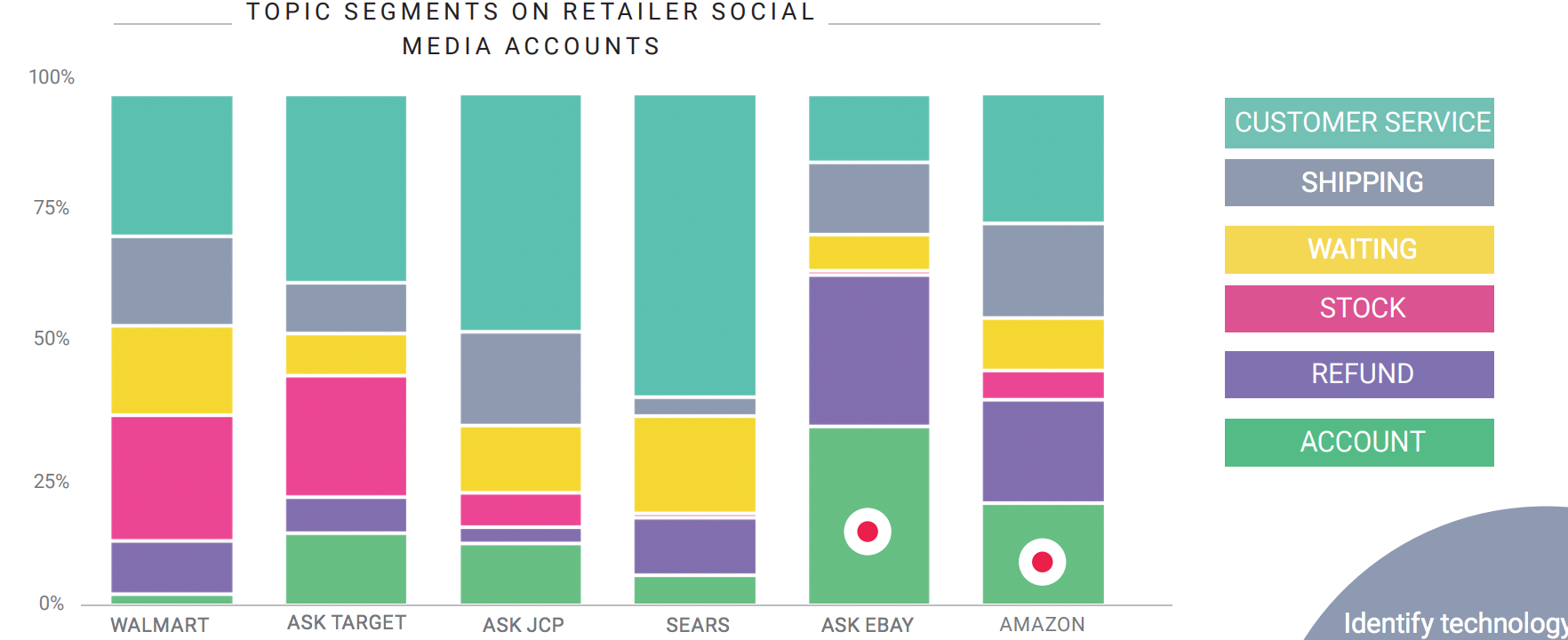Share this
40 New Retail Industry Insights & Trends
by Infegy Research Team on February 12, 2019
If you’re on a team for a retail brand, you know all too well the ups and downs of trying to stand out in a rapidly evolving market.
The confluence of technology, changing consumer habits, and the open access customers have to brands has turned the retail industry on its head.
Add on the ever-increasing choices people have to pick brands they love, and you have a recipe for an obstacle that even the most seasoned retail brands are challenged to overcome.
How can you stand out in all the noise? How can you offer customer experiences that make people want to choose you?
Retail brands like Target, Walmart, Kohl's and Amazon can learn how consumers are shopping differently, see what forces are driving those preferences, and apply those learnings to their business and brand marketing strategy.
So, what are some highlights from the 40+ insights in the retail report? Let’s dive in to some of the can’t miss analysis found inside:
Takeaway #1 - Amazon Owns Consumer Conversations (and Sales)
You’re now well aware of the Amazon effect. The juggernaut company has transformed how people shop. And in that, it’s no surprise that it dominates the online retail industry it initially propelled.
What you should know first is that all retail sales are not declining, as some might assume. Retail sales are climbing.

That's where online shopping comes in.
Our research shows that 5 brands (Amazon, Walmart, Etsy, Ebay and Target) account for 95% of all online shopping traffic. We also found that online retail sales from the last year, Amazon dominates, accounting for 50% of all online shopping sales.
Our social listening analysis in our report shows that Amazon also dominates online conversations.
Amazon is the global leader in online conversations about e-commerce brands, owning online share-of-voice. This means consumers aren’t just shopping with Amazon, they’re talking about the brand too.

With more people talking about them, talking with them, and helping to spread their message, it only becomes easier for Amazon to stand out in the crowd, lead the industry, and keep the conversation, and competitive advantage, on their terms.
As the company continues to own the online conversation, they clearly will drive the online retail industry and force brands to adapt to them.
Takeaway #2 - Social Listening Reveals the Top Customer Service Topics for Shoppers
Consumers are an angry tweet away from companies at all times. This unprecedented access has created an open forum of online conversations that engage these brands directly.
Looking at the top categories amongst retailer social accounts, you can see which draws the most attention from consumers.

Social listening analysis reveals more than just the messages aimed directly at the brands to show what people discuss regarding customer service.
Consider this tweet:

Notice, the brand isn’t tagged, and if Walmart isn’t listening with the right tools and resources, they might miss this Tweet, or fail to account for it in their analytics when they measure customer sentiment and satisfaction.
Takeaway #3 - Younger Shoppers Shop Differently and Have a Clear Favorite Brand
Different retailers resonate with different audience segments.
Social listening analysis can dig into the age-distribution amongst online audiences who discuss various entities.
In our report, we look at Amazon, Walmart, Costco and Target to see which brands own what age segments.
For younger audiences, one clear retailer emerges as a winner: Target.

Age segment
Younger age groups like millennials and Gen-Z account for nearly 60% of all conversations about Target in the last 2 years.
So, how do these younger audiences shop and how do their shopping experiences and feelings differ from the rest of consumers?
Takeaway #4 - See Which Holidays Are Most Popular Amongst Different Groups
Social listening helps brands see which demographic groups favor and discuss certain topics and events most.
So, when we looked at which shopping holidays mattered most to various ages and the gender distribution of online posts, clear differences appear.

The technology can also get super granular with the research amongst these demographics.
For example: when do Gen-Z audiences most engage with Cyber Monday shopping? Mid-day? Late night?
Takeaway #5 - Retail Apocalypse Can Be Avoided
People aren’t abandoning shopping. They’re just shopping differently. If sales revenue reporting is to be believed, most retail companies are growing, not shrinking.
But some types of retail brands are failing to adapt to consumers’ changing shopping habits. Our social listening report for the retail industry highlights just that, looking at the types of businesses and brands that struggle with this.
Consumers are telling retailers what they want in a shopping experience. There’s no magic pill or secret formula to surviving (and thriving) in this retail environment. The answer is simple.
The most important takeaway in our report for retailers is this: they need to listen to consumers. This is the best way to maintain a healthy retail brand.
Keeping a close watch on the pulse of the community and finding hidden consumer insights and trends while also monitoring discussions online, they can stay ahead of the curve.
Conclusion
So, how can you help your retail brand stand out in all that noise?
Embrace the noise.
By analyzing the online conversations and digging into the data about consumer shopping experiences, we can get a fascinating and insightful understanding of the state of the retail industry as a whole.
If you have a physical storefront, how do you balance the influx of online shopping with the desire to increase foot traffic? If you’re an online retail brand, how do you meet and manage consumer expectations?
The answers will vary depending on the goals for your business, but the path to answer those questions are the same: listen.
The details lie in the massive universe of online conversation, where people share their thoughts, feelings, experiences and emotions unsolicited. Having a social listening tool like Infegy Atlas can help you analyze those conversations to find the most important insights.
Share this
- April 2024 (1)
- March 2024 (3)
- February 2024 (3)
- January 2024 (2)
- December 2023 (3)
- November 2023 (4)
- October 2023 (3)
- September 2023 (3)
- August 2023 (4)
- July 2023 (4)
- June 2023 (3)
- May 2023 (4)
- April 2023 (4)
- March 2023 (4)
- February 2023 (4)
- January 2023 (1)
- December 2022 (3)
- November 2022 (4)
- October 2022 (3)
- September 2022 (3)
- August 2022 (2)
- July 2022 (1)
- June 2022 (1)
- April 2022 (1)
- March 2022 (1)
- January 2022 (1)
- December 2021 (1)
- November 2021 (1)
- October 2021 (1)
- June 2021 (1)
- May 2021 (1)
- April 2021 (1)
- March 2021 (1)
- February 2021 (1)
- January 2021 (2)
- November 2020 (1)
- October 2020 (2)
- September 2020 (1)
- August 2020 (2)
- July 2020 (2)
- June 2020 (2)
- April 2020 (1)
- March 2020 (2)
- February 2020 (2)
- January 2020 (2)
- December 2019 (2)
- November 2019 (1)
- October 2019 (1)
- September 2019 (2)
- August 2019 (2)
- July 2019 (2)
- June 2019 (1)
- May 2019 (2)
- April 2019 (1)
- March 2019 (2)
- February 2019 (2)
- January 2019 (1)